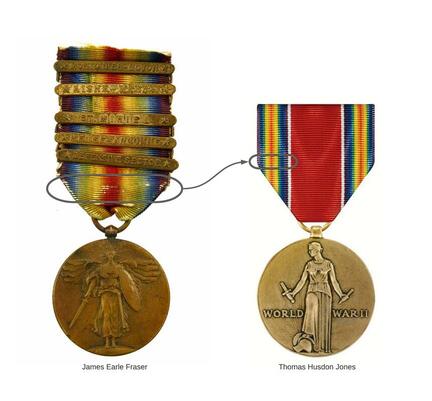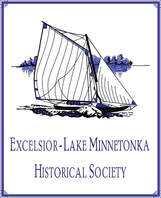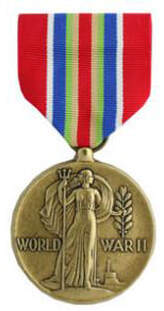12 million people were eligible to received the U.S. World War II Victory Medal, the most of any military campaign award ever issued by the United States. For World War I, about 2.5 million Victory Medals were issued in the U.S.

The WWII medal shares many themes of the earlier award. Each medal is the same diameter, 36 mm, and both medals hang from a ring suspension.
The WWII ribbon borrows the WWI rainbow theme along each edge. The center red color represents Mars, the Roman God of war. At the very bottom of the WWII medal, is the helmet of Mars, which the figure called "Liberation" is stepping on, to show that war was vanquished.
"Liberation" has managed to break a sword and is holding both pieces in her hands. Again, showing the end of war.
The WWII ribbon borrows the WWI rainbow theme along each edge. The center red color represents Mars, the Roman God of war. At the very bottom of the WWII medal, is the helmet of Mars, which the figure called "Liberation" is stepping on, to show that war was vanquished.
"Liberation" has managed to break a sword and is holding both pieces in her hands. Again, showing the end of war.
The female figure on the WWI medal is "Winged Victory." The WWI allied countries agreed to issue similar looking victory medals* for The Great War. They agreed on the same ribbon (or drape), the size of the medal, and some design basics, like some form of Winged Victory. The US Winged victory is holding a shield and sword. Her wings are a bit eagle-like while most of the other allies have angelic looking wings.
The ribbons were made of silk, which often "shatters" with age. The US ribbon could also have battle clasps or operational clasps or service clasps, based on rules established by each branch of the military. (All these rules were confusing and complicated the official issue of awards. Ribbons were of various lengths, depending on the number of clasps, which did not look very uniform.) The WWII Victory Medal was the same for everyone and had no clasps or any attachments. In place of of a clasp like "Defense Sector" in WWII there were individual medals like the Occupation Medal or American Defense Medal, all designed to hang at the same length.
An excellent reference for the original Victory Medals of World War I is James P. Michels Jr.'s book, "World War I Victory Medals," 2001, Creatspace.
* The British were not too excited about the joint Victory Medal. They had already issued their own War Medal with King George V on the front and a naked Saint George riding a horse that is trampling a skeleton. When displayed together, the British War Medal and Victory Medal were nicknamed "Mutt and Jeff."
The ribbons were made of silk, which often "shatters" with age. The US ribbon could also have battle clasps or operational clasps or service clasps, based on rules established by each branch of the military. (All these rules were confusing and complicated the official issue of awards. Ribbons were of various lengths, depending on the number of clasps, which did not look very uniform.) The WWII Victory Medal was the same for everyone and had no clasps or any attachments. In place of of a clasp like "Defense Sector" in WWII there were individual medals like the Occupation Medal or American Defense Medal, all designed to hang at the same length.
An excellent reference for the original Victory Medals of World War I is James P. Michels Jr.'s book, "World War I Victory Medals," 2001, Creatspace.
* The British were not too excited about the joint Victory Medal. They had already issued their own War Medal with King George V on the front and a naked Saint George riding a horse that is trampling a skeleton. When displayed together, the British War Medal and Victory Medal were nicknamed "Mutt and Jeff."
|
The United States Merchant Marine had its own WWII Victory Medal, with similar themes. This medal was designed by John Sinnock. Lurking near the bottom of the medal is a submarine, which was the greatest threat to Merchant Marine ships. The Merchant Marine consists of privately owned ships and civilian personnel who can serve as a U.S. naval auxiliary in a time of war or national emergency. These private ships were used to transport cargo and troops during WW2, and other conflicts. Merchant Mariners were civilians but worked under the direction of the US Navy. In 1988, a Federal Judge ordered that Merchant Mariners were entitled to "veterans recognition" which included some benefits. Suggested reading: Michael Gillen's, "Merchant Marine Survivors of World War II," 2014 |

